Related Research Articles

Cable television is a system of delivering television programming to consumers via radio frequency (RF) signals transmitted through coaxial cables, or in more recent systems, light pulses through fiber-optic cables. This contrasts with broadcast television, in which the television signal is transmitted over the air by radio waves and received by a television antenna attached to the television; or satellite television, in which the television signal is transmitted by a communications satellite orbiting the Earth and received by a satellite dish on the roof. FM radio programming, high-speed Internet, telephone services, and similar non-television services may also be provided through these cables. Analog television was standard in the 20th century, but since the 2000s, cable systems have been upgraded to digital cable operation.

Coaxial cable, or coax is a type of electrical cable consisting of an inner conductor surrounded by a concentric conducting shield, with the two separated by a dielectric ; many coaxial cables also have a protective outer sheath or jacket. The term "coaxial" refers to the inner conductor and the outer shield sharing a geometric axis.
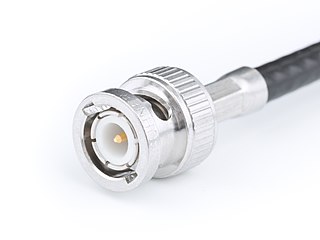
The BNC connector is a miniature quick connect/disconnect radio frequency connector used for coaxial cable.

A coaxial RF connector is an electrical connector designed to work at radio frequencies in the multi-megahertz range. RF connectors are typically used with coaxial cables and are designed to maintain the shielding that the coaxial design offers. Better models also minimize the change in transmission line impedance at the connection in order to reduce signal reflection and power loss. As the frequency increases, transmission line effects become more important, with small impedance variations from connectors causing the signal to reflect rather than pass through. An RF connector must not allow external signals into the circuit through electromagnetic interference and capacitive pickup.
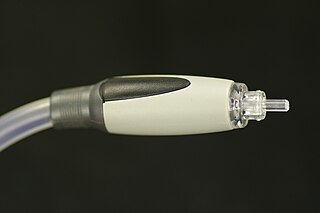
S/PDIF is a type of digital audio interconnect used in consumer audio equipment to output audio over reasonably short distances. The signal is transmitted over either a coaxial cable with RCA connectors or a fiber optic cable with TOSLINK connectors. S/PDIF interconnects components in home theaters and other digital high-fidelity systems.

A balun is an electrical device that converts between a balanced signal and an unbalanced signal. A balun can take many forms and may include devices that also transform impedances but need not do so. Transformer baluns can also be used to connect lines of differing impedance. Sometimes, in the case of transformer baluns, they use magnetic coupling but need not do so. Common-mode chokes are also used as baluns and work by eliminating, rather than ignoring, common mode signals.
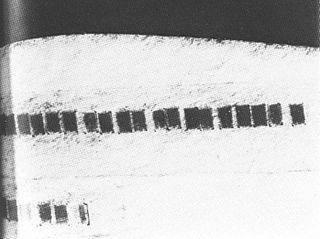
A microdot is text or an image substantially reduced in size to prevent detection by unintended recipients. Microdots are normally circular and around one millimetre in diameter but can be made into different shapes and sizes and made from various materials such as polyester or metal. The name comes from the fact that the microdots have often been about the size and shape of a typographical dot, such as a period or the tittle of a lowercase i or j. Microdots are, fundamentally, a steganographic approach to message protection.

The F connector is a coaxial RF connector commonly used for "over the air" terrestrial television, cable television and universally for satellite television and cable modems, usually with RG-6/U cable or, in older installations, with RG-59/U cable.
Hybrid fiber-coaxial (HFC) is a telecommunications industry term for a broadband network that combines optical fiber and coaxial cable. It has been commonly employed globally by cable television operators since the early 1990s.

SMC connectors are coaxial RF connectors developed in the 1960s. The interface specifications for the SMC and many other connectors are referenced in MIL-STD-348. They use a #10-32 UNF threaded interface. They offer electrical performance from DC to 10 GHz. Female SMC connectors have a socket for the center contact, and male SMC connectors have a pin for the center contact. SMC jack connectors have an external thread while SMC plug connectors have the mating hex nut. Available in 50-Ohm and 75-Ohm characteristic impedance, they provide an interconnect means for small form factor coaxial cables and printed circuit boards where small footprint is important.

The Belling-Lee connector is commonly used in Europe and Australia to connect coaxial cables with each other and with terrestrial VHF/UHF roof antennas, antenna signal amplifiers, CATV distribution equipment, TV sets, and FM and DAB radio receivers. In these countries, it is known colloquially as a PAL antenna connector, IEC antenna connector, or simply as a TV aerial plug. It is one of the oldest coaxial connectors still commonly used in consumer devices. For television signals, the convention is that the source has a male connector and the receptor has a female connector. For FM radio signals, the convention is that the source has a female connector and the receptor has a male connector. This is more or less universally adopted with TV signals, while it's not uncommon for FM radio receivers to deviate from this, especially FM radio receivers from companies not based in the areas that use this kind of connector.

Multichannel Audio Digital Interface (MADI) or AES10 is an Audio Engineering Society (AES) standard that defines the data format and electrical characteristics of an interface that carries multiple channels of digital audio. The AES first documented the MADI standard in AES10-1991, and updated it in AES10-2003 and AES10-2008. The MADI standard includes a bit-level description and has features in common with the two-channel AES3 interface.

MMCX connectors are coaxial RF connectors similar to MCX but smaller. They conform to the European CECC 22000 specification. MMCX connectors are rated to 500 pairing cycles.

A coaxial power connector is an electrical power connector used for attaching extra-low voltage devices such as consumer electronics to external electricity. Also known as barrel connectors, concentric barrel connectors or tip connectors, these small cylindrical connectors come in an enormous variety of sizes.
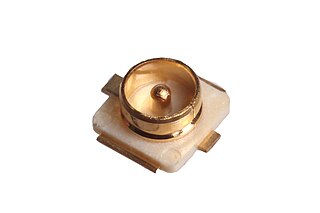
Hirose U.FL, I-PEX MHF, IPX, AMC or UMCC is a miniature RF connector for high-frequency signals up to 6 GHz manufactured by Hirose Electric Group, I-PEX, and others.
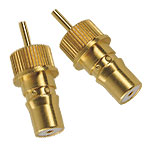
QMA and QN connectors are quick-connect RF connectors that were designed to replace the widely used SMA and Type N connectors. The connectors have been available since 2003. The connector family was created by the Quick Lock Formula Alliance, which consists of Huber+Suhner, Radiall, Rosenberger Hochfrequenztechnik, and Amphenol.

UPC is the largest cable operator in Switzerland with around 1.1 million residential and business customers and was formed in 1994 through the merger of several cable operators.
Audio connectors and video connectors are electrical or optical connectors for carrying audio and video signals. Audio interfaces and video interfaces define physical parameters and interpretation of signals. For digital audio and digital video, this can be thought of as defining the physical layer, data link layer, and most or all of the application layer. For analog audio and analog video these functions are all represented in a single signal specification like NTSC or the direct speaker-driving signal of analog audio. Physical characteristics of the electrical or optical equipment includes the types and numbers of wires required, voltages, frequencies, optical intensity, and the physical design of the connectors. Any data link layer details define how application data is encapsulated. Application layer details define the actual audio or video format being transmitted, often incorporating a codecs not specific to the interface, such as PCM, MPEG-2, or the DTS Coherent Acoustics codec. In some cases, the application layer is left open; for example, HDMI contains an Ethernet channel for general data transmission.
The Hirose W.FL, also known as I-PEX MHF3 or Amphenol AMMC, is an ultra small RF connector used in handheld electronic products. It is manufactured by Hirose Electric Group and has a frequency range up to 6 GHz. Compared to its predecessor U.FL it occupies even less area and height (1.4 mm).